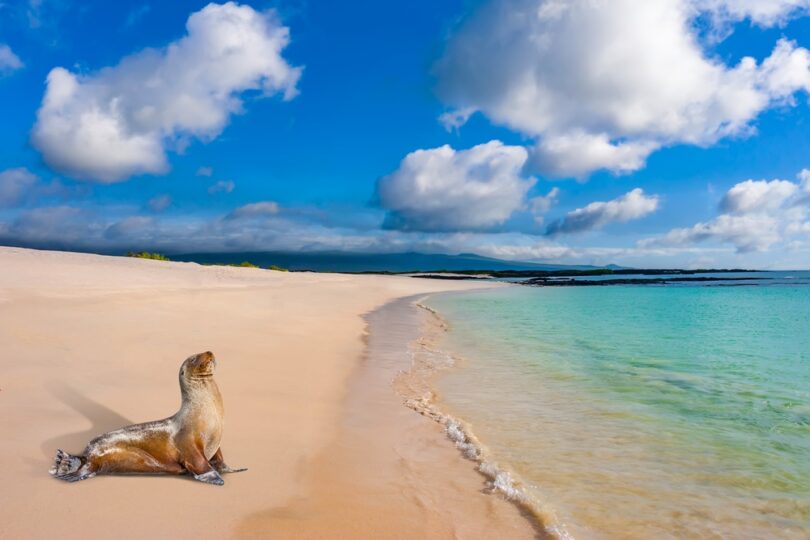An expedition to the Galápagos Islands is a step back in time to a place where nature’s untamed beauty unfolds at every turn. Situated in the Eastern Pacific — about 600 miles off the coast of Ecuador, which claims the islands as their own — the Galápagos are a living museum. Here, wildlife exists as it has for millennia, untouched by the hustle of the modern world.
The Galápagos Islands are not only a sanctuary for an astonishing variety of marine and terrestrial life but also a pivotal chapter in the annals of science. The islands gained historical significance through the visit of Charles Darwin in 1835. It was here, amidst the distinct biodiversity of the Galápagos, that Darwin found the inspiration and crucial observations that would lead to his groundbreaking theory of natural selection. This archipelago served as a natural laboratory, providing evidence that would forever change our understanding of life on Earth.
Today, travelers to the Galápagos Islands can trace the footsteps of Darwin, exploring the same enchanted landscapes that fueled one of science’s most significant discoveries. From the vibrant streets that blend into dramatic volcanic terrains, to the serene beaches and underwater worlds teeming with life, the Galápagos offers an array of experiences. Each island presents its own array of wonders, inviting adventurers to a vacation filled with discovery and awe.

Giant Tortoise, Galapagos Islands
Santa Cruz Island
Welcome to Santa Cruz Island, the bustling heart of the Galápagos! We suggest you to start your adventure at the Charles Darwin Research Station, where giant tortoises roam freely and scientists work hard on crucial conservation projects. Then, experience the vibrant Fish Market, which is not just a place to buy seafood but rather a lively interaction zone where sea lions and pelicans cheekily vie for the fishermen’s catch, illustrating the island’s harmonious blend of wildlife and community life.
Next, take a leisurely stroll along Avenida Charles Darwin, dotted with quaint shops and local eateries, capturing the island’s charm. Don’t miss the serene beauty of Tortuga Bay, a pristine beach home to sunbathing marine iguanas and nesting sea turtles, offering a perfect escape into nature’s embrace. Santa Cruz encapsulates the essence of the Galápagos: groundbreaking conservation, intimate wildlife encounters, and breathtaking natural scenery, all inviting you to immerse yourself in the islands’ allure.
Isabela Island
For an unforgettable journey on Isabela Island, start with the mesmerizing Sierra Negra Volcano. Lace up your hiking boots for a trek that offers stunning views of the world’s second-largest volcanic crater, immersing you in the sheer magnitude of nature’s force. After exploring the volcanic landscapes, delve into the island’s poignant history at the Wall of Tears, an evocative monument to its past as a penal colony. Wander the surrounding trails and absorb the somber beauty and historical depth of this site.
Isabela’s allure extends beyond its terrestrial wonders to a vibrant underwater world. Begin your aquatic adventure at the Tintoreras Islets, where snorkeling brings you face-to-face with marine iguanas, frolicking sea lions, and the enchanting Galápagos penguins. Continue your exploration in the magical marine environs of Los Túneles. Here, the clear waters invite you to snorkel alongside sea turtles, seahorses, and rays, offering a glimpse into the rich biodiversity that thrives beneath the waves.

Male Great Frigatebird, Genovesa Island, Galapagos National Park
Genovesa Island
A true birdwatcher’s paradise in the Galápagos, Darwin Bay is a horseshoe-shaped bay surrounded by cliffs where you’ll be greeted by plenty of vivacious seabirds. As you stroll along the sandy trails, get ready for close encounters with red-footed boobies, great frigatebirds, and Nazca boobies. It’s like stepping into a living aviary. Take a hike to Prince Philip’s Steps, a rocky path leading to a stunning plateau. This is your front-row seat to the mesmerizing courtship displays of frigatebirds, along with the chance to spot storm petrels and blue-footed boobies.
Snorkeling enthusiast? Good news. Whether you stay at Darwin Bay or head to El Barranco, an unforgettable underwater expedition awaits you. Dive into the crystal-clear waters surrounded by playful sea lions and tropical fish and find out why the vibrant marine life is a perfect testament to the Galapagos’ incredible biodiversity.
Bartolomé Island
Any trek to Bartolomé Island should start at Pinnacle Rock, an iconic volcanic formation that rises dramatically from the sea. Climb to the summit for panoramic views that will take your breath away. It’s like being on top of the world with the Galápagos at your feet. This summit is a particularly inviting spot for sunrise or sunset enthusiasts, with the sun casting its golden hues over the volcanic landscape and creating a mesmerizing play of light and shadow. It’s a photographic paradise, so don’t forget to get your camera ready.
If you plan to have an underwater getaway instead, Bartolomé’s water won’t disappoint you. Snorkel around the base of Pinnacle Rock, where playful Galápagos penguins, tropical fish, and even sea lions roam free. Every step — or dive — on Bartolomé is a journey into the heart of the archipelago’s geological wonders.

Sea Lions, Española Island
Española Island
Welcome to Española Island, a haven for wildlife enthusiasts and home to some of the Galápagos’ most iconic inhabitants. Begin your journey at Gardner Bay, a pristine white-sand beach where sea lions bask in the sun. This is your chance to share the sand with these playful creatures, or grab your snorkel gear and explore the underwater world teeming with colorful fish.
For a birdwatching spectacle, head to Punta Suárez. Here you will admire the elaborate courtship dances of the waved albatrosses. This is the only nesting site for these magnificent birds in the whole archipelago. Blue-footed boobies, marine iguanas, and Nazca boobies also call this rugged coastline home. Gardner Islet, just off the coast of Española, offers a fantastic snorkeling opportunity. Keep an eye out for sea turtles, rays, and vibrant fish while exploring its crystal-clear waters.
You May Also Like: ¡Buen Viaje! Great Cheap Countries to Visit in Central & South America

Iguana, North Seymour Island, Galapagos
North Seymour Island
Our journey through Ecuador‘s prized archipelago concludes on the captivating North Seymour Island, where nature takes center stage, offering unparalleled wildlife encounters. This island enchants visitors with the whimsical courtship dances of the blue-footed boobies and provides opportunities to swim in crystal-clear waters, surrounded by a kaleidoscope of colorful fish and playful sea lions, bringing you face-to-face with the Galápagos marine life.
As you meander along the island’s trails, the air is filled with the graceful flight of frigatebirds, while marine iguanas bask on sunlit rocks. Keep your eyes peeled for swallow-tailed gulls and land iguanas, each step unveiling a new and delightful discovery. For a breathtaking panoramic view, make your way to the summit of North Seymour Hill. From this vantage point, you can soak in the island’s distinctive beauty and observe the diverse birdlife that inhabits this special place, truly capturing the essence of North Seymour Island’s natural splendor.
FAQs:
Q: How do I get to the Galápagos Islands?
A: You can fly into the Galápagos Islands from mainland Ecuador. Flights depart from Quito or Guayaquil to Baltra Island or San Cristóbal Island.
Q: Do I need a visa to set foot in the Galápagos Islands?
A: Most visitors do not need a visa to visit the Galápagos Islands if they are staying for less than 90 days. However, it’s essential to check the visa requirements for your nationality.
Q: What is the best time of year to visit the Galápagos Islands?
A: The Galápagos will welcome you year-round. However, the dry season from June to December is considered the best time for wildlife viewing and snorkeling.
Q: Are there any entry restrictions or fees for visiting the Galápagos Islands?
A: Visiting the Galápagos Islands requires paying an entry fee to the Galápagos National Park. Visitors must also obtain a transit control card at the airport upon arrival. This card is essential for regulating tourism and protecting the islands’ ecosystem. It tracks visitor numbers and movements, supporting sustainable tourism and conservation efforts.
Q: Do I need to speak Spanish to visit the Galápagos Islands?
A: While many locals speak Spanish, English is widely spoken in tourist areas. Of course, knowing some basic Spanish phrases can definitely enhance your experience and interactions with locals.
Q: Are there any medical facilities available on the Galápagos Islands?
A: Yes, there are medical facilities available on the Galápagos Islands. However, they may be limited, so it’s highly recommended to purchase travel insurance that covers medical emergencies.
Q: Can I drink tap water on the Galápagos Islands?
A: It’s generally not recommended to drink tap water on the Galápagos Islands. Better stick to bottled water to avoid any potential health issues that might ruin your vacation!
Have you visited the Galapagos Islands? How was it? Tell us all about it in our comments section below!








